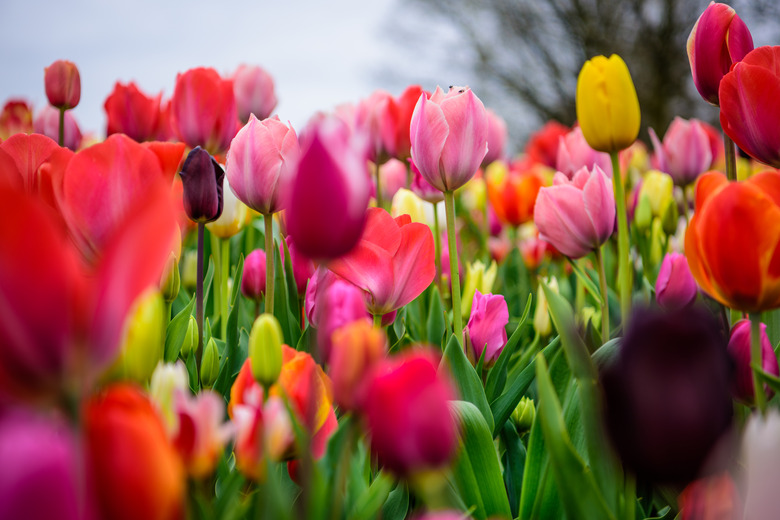Tulip Flower Description
Tulips (Tulipa spp., USDA zones 3-8) come in a rainbow of colors, making them a varied group of blooms for your garden. Many tulips have the distinct cup shape that makes the blooms easy to identify, but others have a slightly different shape. A tulip flower also has a distinct structure and bulb and root system that makes them unique. Learning the differences makes it easier to identify tulips.
Tulip Flower Basics
Tulips, a large group of approximately 100 species, include over 3,000 varieties of flowering plants. The flowers vary greatly in size, shape and form, depending on the cultivar. Tulips are perennials in U.S. Department of Agriculture plant hardiness zones 3 through 8. Although they are perennials, some gardeners choose to grow tulips, especially the hybrid varieties, as annuals because their blooms aren't always as spectacular the second and subsequent years, especially in the warmer climates of the hardiness zone range.
Tulip Blossoms
The common tulip description includes a cup-shaped blossom, but some cultivars have a star or bowl form. All tulip flowers have six petals. The petals can be smooth, fringed or ruffled. Blossoms may be single or double.
The flowers come in nearly every color except true blue. Some tulip blossoms are single-colored, while others are striped, swirled, flamed from the bottom or edged with a contrasting color on the petals. Their leaves are usually medium green in color, with a lance or oval shape.
Tulip plants range in size from 4 to 24 inches in height, with an upright form. Tulip blossoms open during the day but close in the evening. These plants are phototropic, meaning they bend toward the light. Even cut flower stems will bend toward the light when arranged in a vase.
Blooming Classifications
Tulips are grouped according to whether they flower early, mid-season or late. Species tulips, for example, bloom early in the season around March or early April, while Darwin hybrids bloom mid-season, in April and at the beginning of May. Parrot, double late and lily-flowered tulips are late bloomers. They usually don't start blooming until May.
Scented Cultivars
Most tulips aren't especially aromatic, but some cultivars such as Couleur Cardinal, with dark red flowers, Generaal de Wet, with soft orange blooms, and Apricot Beauty, with soft apricot blossoms, are sweetly fragrant as well as showy. Most fragrant tulips are early-blooming types, but several cultivars such as Holland's Glory, a 2-foot-tall cultivar with large reddish-orange blossoms, and Silverstream, a creamy-white blossom with pink-edged leaves, bloom in mid-season.
Bulbs and Root System
Tulips grow from tunicate bulbs. This type of bulb has a thin, papery covering on the outside that protects the inner storage tissue from injury. Each bulb produces one flower. The center of the bulb holds the developing flower bud and is surrounded by the developing leaf and leaf scale.
The roots grow from the bottom of the bulb, called the basal plate. Lateral buds grow just above the basal plate. These lateral buds are smaller bulbs called bulblets. The bulblets eventually produce new tulip plants.
Plant Structure
All tulips have a perianth composed of six petals and six sepals. Sepals are the small leaf-like structures at the bottom of the flower that once protected the flower bud.
Tulips are classified as perfect and complete flowers, which means the tulip structure contains both male and female parts. Each blossom contains six male reproductive organs called stamens. Stamens are composed of a filament topped by a pollen sac called an anther.
Each flower also contains a three-lobed female part called a pistil. Inside the pistil, a tube called a style connects an ovary to the stigma, a receptacle that collects the pollen during the fertilization process. Birds, insects and wind carry the pollen from the anther to the stigma. Once fertilized, fruit and seeds form inside the ovary.
